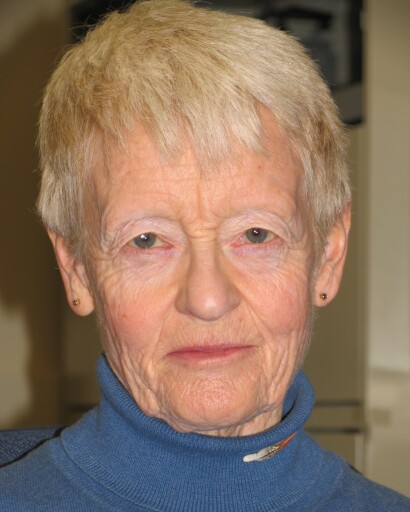

Mary Meagher
March 13, 1935 — October 4, 2023
Gardiner
DR. MARY MEAGHER, 1935-2023
Margaret Mary Meagher was born on March 13, 1935 in Spokane, Washington, and died peacefully October 4, 2023 at her home in the Cinnabar Basin in Montana. She was a trailblazer not only for women within the National Park Service, but women in science in general, by entering the field of wildlife biology when it was nearly impossible for women to find employment in the field. She became an internationally recognized expert on the American bison. As such, she was not only invited to speak numerous times over the years, but was called as an expert witness as well.
Mary earned both a B.S. and M.S. in wildlife management from the University of Michigan. Her science background and passion for wild spaces led her to participate in the Student Conservation Association in Olympic National Park, where she studied marmots and discovered her passion for fieldwork. She was later employed as a seasonal interpretive park ranger in Zion National Park. Finally, in 1959, an offer came from Yellowstone National Park as curator of the park’s historic and archival records. She ultimately overcame the gender restrictions of her era to become both a wildlife biologist and park ecologist. She earned her doctorate from the University of California at Berkeley in 1970, becoming the first woman with a doctorate in wildlife biology in the National Park Service. After completing her Ph.D. dissertation, The Bison of Yellowstone National Park, was published by the National Park Service in 1973 and remains a leading text in the field. She spent her entire career in Yellowstone Park.
Fiercely independent and deeply content with solitude, Mary lived for much of her Yellowstone tenure in a National Park Service cabin on the Blacktail Plateau with her horse, moving into winter quarters in Mammoth Hot Springs only when winter weather forced her to. Her backcountry wildlife studies within the park were conducted on horseback in the summer and on skis in the winter, most often on solitary excursions, and many before radios or other communications were available. She often said one simply dealt with the backcountry best you could. She always managed to reappear, even if it was a little worse for wear. Her long struggle to be admitted into roles traditionally reserved for men made her reluctant to ask for help, resulting in some colorful stories about getting herself out of difficult situations. On one solitary research excursion, an encounter with a bear resulted in her being thrown from her horse and breaking her arm in seven places. She created a makeshift sling from her shirt, remounted her horse and rode eighteen miles to the Lamar Ranger station, where a colleague had to persuade her to let him unsaddle her horse so she could get medical attention.
Mary served as Supervisor of the Wildlife Division in Yellowstone from 1976 to 1983. She left that position for her preferred post as a wildlife researcher, which she held until her retirement in 1997. She not only provided the data and analysis which leads to our present understanding of bison in Yellowstone National Park, but she was also instrumental in the controversial decision to force bears back to natural foods by closing the dumps in the Park that attracted them.
In her retirement, from 1997 until 2008, Mary assisted with archaeological fieldwork, documenting and evaluating historic structures, old roads, and changes in vegetation. Her prior experience with the archives was put to excellent use during these years, especially through her collaboration with Dr. Douglas Houston to retake early historic photographs and document the way the landscape had altered since the earliest photographs of the park were taken over a hundred years earlier. Her many years in the backcountry facilitated this effort, which required extensive searching to find the exact positions from which the early photographs had been taken. The book resulting from this effort, Yellowstone and the Biology of Time, provides striking visual documentation and interpretation of vegetation changes resulting from both climate change and practices such as fire suppression.
Mary was an exemplar of what it means to be an ecologist. She was deeply cognizant of the interconnections of flora, fauna, landscape and climate, and of how people both past and present interact with and impact the whole. She continued observing, asking questions, and learning her entire life. She was fond of saying that the bison, bears and her horses had been her teachers over the years. She embodied what it means to live lightly on the earth, consuming little, wasting nothing, and passing on her resources to organizations committed to environmental protection. She was an inspirational example to women of her own generation and those who followed, especially to her nieces, grand-nieces, and cousins, demonstrating a lifetime of persistence in the face of discrimination. She was a patient teacher, a good friend, and a willing resource for those asking “how?” and “why?”. She made a mean elk stew and an exquisite huckleberry pie and enjoyed a good glass of red wine.
Mary was preceded in death by her parents, Tom and Mary Meagher, and her sister, Patricia Houff. She is survived by her brother, Michael Meagher, her three nieces and four nephews and their children, cousins, and by her many friends.
Per Mary's request no services will be held.
Please visit below to share a memory or offer condolences.
Guestbook
Visits: 665
This site is protected by reCAPTCHA and the
Google Privacy Policy and Terms of Service apply.
Service map data © OpenStreetMap contributors


